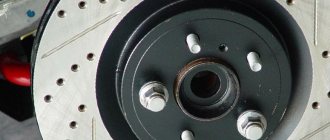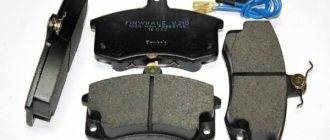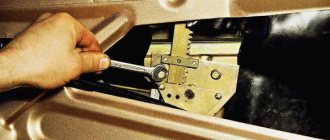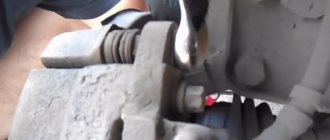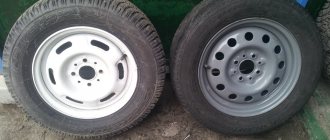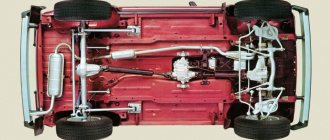Why do brake discs get hot?
Heating is not a malfunction if it occurs evenly on both sides and the temperature value does not exceed acceptable limits. In this article, by the word “heat” we mean overheating.
Most discs are made from cast iron. This metal is suitable for daily use - it is inexpensive and has good frictional properties. But it also has its drawbacks: due to frequent braking, the cast iron gets very hot, even to the point of smoke. The pads begin to melt and warp.
To reduce heating, or rather, speed up cooling, discs are produced with voids inside (ventilated). This has almost no effect on the characteristics.
To improve performance, perforations and alloys began to be used. If you replace standard brakes with drilled ones, they will cool down faster.
Why do brake discs get hot? The cause is almost always friction. In 99% of cases. And it doesn’t matter whether the front ones are heated or the rear ones, left or right. Having discovered a problem, car enthusiasts usually check the free play of the wheel:
- remove the car from the handbrake or gear;
- jack up the car;
- spin the wheel.
If you hear a rustling sound or the wheel rotates with force, the problem is most likely in the brake caliper, which does not release the pad (or pads) even when the pedal is released.
Often, rust covers the cylinder bore or the outer walls of the brake piston, which prevents it from moving freely. It can also cover the guides. Restoring a caliper at a service station is called development. It is necessary to change the rubber seals - this can only be done if you have a repair kit. Sometimes you have to change the piston too.
How to check the free play of a wheel if it gets hot
After a malfunction is detected, the car owner can diagnose free wheel movement. To do this he:
- removes the car from the handbrake or gear;
- lifts the car using a jack;
- spins the wheel.
If there is a rustling noise or the wheel turns with difficulty, then most likely there is a breakdown in the brake caliper. It holds one or both pads when the pedal is depressed.
The free movement of the caliper is often hampered by rust that covers the cylinder bore or the outer surface of the brake piston. Sometimes it can be found on the guides. The service station offers a caliper restoration service - development. It consists of replacing rubber seals. For this you need a repair kit. Sometimes it is even necessary to change the piston.
Another reason why the wheel heats up and rotates with force is a worn wheel bearing (when the brake disc overheats on one side). When its temperature rises, it transfers heat to the disc brake. This process can be noticed if you hear a hum while driving at a certain speed.
Sometimes the wheel moves easily when suspended, but during driving it gets so hot that it burns your fingers. This is due to the following reasons:
- The discs are worn out or deformed. As they become thinner, they heat up faster.
- Poor quality pads were installed.
- You replaced the brake fluid with the wrong one.
- The pads are very worn.
- When heavy pressure is applied to the front axle during braking, the front brake discs of cars with rear drum brakes heat up.
- Aggressive driving with acceleration and sudden stops prevents the brake system from cooling.
- Internal delamination of the brake hose does not allow the brake fluid to circulate, which means it will be difficult for the pads to separate.
- Another reason is air in the brake system.
We recommend
Requirements
There are several requirements for brake discs. They must be durable, resistant to thermal shock and have high thermal conductivity. Brake discs also have good adhesion and a high coefficient of friction. Only if all these parameters are met, wheels can be installed on a production car. Otherwise, traffic safety will be in question. If the pads overheat, they will simply slide across the working surface, not performing their main functions - friction and adhesion.
Pads
Now let's move directly to the mechanical part. The first thing you should pay attention to is the pads. There is friction material on their surface. This pad has special wear marks. When the layer is less than three millimeters, the part needs to be replaced. Otherwise, the heating coefficient will increase - metal will rub against metal. Should the front brake discs get hot? Of course not. If the pads are worn down to the ground, at one point they may simply jam. The car will skid. Don’t delay installing new ones - change the pads according to the regulations. It ranges from 20 to 30 thousand kilometers. And since a lot depends on the driving style, the manufacturer has identified special risks in the middle of the pads.
How to prevent overheating
In order to prevent the brakes from overheating, the main contribution is, of course, made by manufacturers, using the most heat-conducting materials for their manufacture and developing ventilated structures in which the brake discs consist of two parts, with a special fan built between them.
The design of the brake disc itself, capable of self-cleaning from dirt and being ventilated by oncoming flow, is considered one of the most successful design discoveries. In order to prevent overheating of the brakes during operation, it is necessary, first of all, to maintain the brake system in working condition, and for this you need to regularly check:
- brake fluid level in the master cylinder reservoir;
- brake disc thickness;
- brake pad wear.
None Under no circumstances should you cool hot brake discs with cold water - a sharp temperature change is the main reason for their warping. Before washing your car after a trip, you also need to give them time to cool down.
It is also important to change your driving style, get rid of jerky driving, use engine braking more often, shifting it to lower gears before stopping and on descents. This will not only prevent overheating of the brakes, but will also preserve the service life of its elements and many other parts of the car.
Long-term storage of a car outside the garage leads to the fact that, under the influence of precipitation, the metal parts of the brake pads become corroded and this causes them to jam.
Any motorist can deal with this problem, as well as replacing the pads, himself, since this is a simple procedure. To do this, you need to remove the wheel, unscrew the caliper, pull out the jammed pad, clean it of rust and put it in place (it should move easily along the guides).
If the thickness of the linings turns out to be about 2 mm, then it is better to replace them with new ones, without waiting for them to wear down to sizes below critical, and this must be done on both wheels of the axle, otherwise the car will skid to the side when braking. Manufacturers recommend replacing warped discs immediately, but our “Kulibins” have learned how to sharpen them and even have recommendations to do this after three pad replacements.
Regular inspection of the brake system, maintaining them “in constant combat readiness,” and careful driving are the key to safety, and often to the preservation of the life and health of the driver and those around him.
The situation is familiar: you replaced the brake pads and discs, but after 10-50 km they began to get very hot, did an uncharacteristic knocking sound appear? The first thought is “probably they haven’t gotten used to it yet.” However, when in addition an unpleasant, disturbing burning smell appears, the opinion changes. The mechanical components of the brake system must be installed carefully.
If the elements are poorly cleaned or an error is made during installation, friction will arise between them. The result is overheating.
The causes of problems may be different:
- Wedging of the brake caliper guides. Leads to uneven clamping of the pads.
- The inner pad and caliper piston are not aligned well enough. If the protrusions do not match, the parts will skew and a large load will arise.
- Incorrectly selected lubricant, poorly applied to the surface.
- The pads are stuck due to insufficient cleaning of the seat in the caliper bracket.
This is how overheating manifests itself
- Before installing the discs, they need to be degreased. Factory lubricant emits an unpleasant odor and smoke when the car is running. This will continue until the lubricant evaporates from the surface. You can determine whether there is lubrication yourself - just run your finger over the surface of the disc.
- Before installation, you need to clean the hub. Insufficient fit of parts can lead to their misalignment and, as a result, increased resistance during movement.
- The caliper pins need to be cleaned of old grease. Then apply a new composition. Applying lubricant to the guides It is unacceptable to use grease, nigrol or another substance that is not a special means to lubricate the caliper fingers. The fingers will jam and the pads will get stuck in one position.
- Check the condition of the staples. The installation of caliper brackets is preceded by checking the fingers for care and return to their extreme positions.
- When the car is on a jack or lift, you should rotate the wheels to make sure that there is no strong friction.
Cleaning the hub
If you have changed brake discs and pads and found that the disc is heating up, this is a signal - you will probably have to disassemble the brake system. When disassembling, follow this algorithm:
- Raise the car on a jack or hang it on a lift. It is important that the wheel where overheating occurs is free.
- Remove the wheel.
- Turn the steering wheel to its extreme position so that the brake system is accessible.
- Using the reverse spade side of the cylinder wrench, press out the caliper piston. To do this, you need to place the tool between the pad and the disc, then apply physical force.
- Bend out the retaining stop of the mounting bolt.
- Remove the staples.
- To release the bracket and fold it down, unscrew the bolt that secures it.
Removing the bracket
Next, act according to the situation - that is, depending on the cause of the malfunction. First of all, check the condition of the disks. They need to be degreased, even if there are no traces of oil.
Clean all components (especially the caliper) if there is dirt on them. Of course, do not forget to lubricate the guides with a special compound.
Disc brakes were invented back in the 20th century, but began to be actively used only in recent decades. It was then that the design of these systems was brought to perfection. Brakes are something that should always be in good working order. However, even this system sometimes fails. So, after some time, the driver begins to notice that the front brake discs are getting very hot. Is this normal? Of course not. And in today’s article we will look at why the front brake discs heat up and what is the reason for this phenomenon.
Useful tips
The fact that the brake elements are overheating is far from the most pleasant news for the car owner.
- Avoid any contact of water with the calipers. Do not drive aggressively in wet or rainy weather.
- Particular attention should be paid to washing. Wait a while for your discs to cool down. If water gets on hot metal, deformation cannot be avoided. In this case, only complete replacement of the disks will save you. Moreover, they are changed in pairs (just like the pads), even if the adjacent one is in good condition.
- Follow the instructions for replacing pads. Don't wait until they wear down to metal. This will cause deformation and increased heating of the disk.
